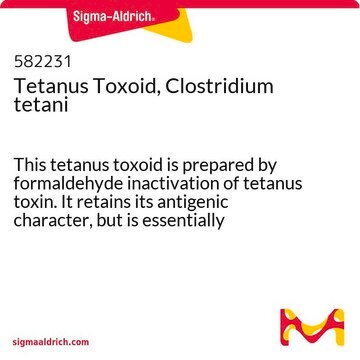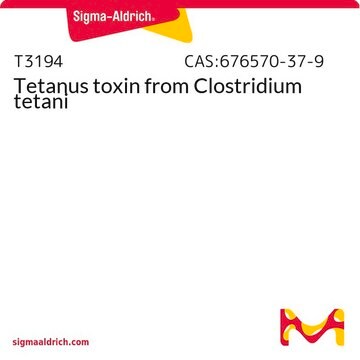T8024
Tetrodotoxin
≥98% (HPLC), powder
Synonyme(s) :
Fugu poison, Maculotoxin, TTX, Tarichatoxin
About This Item
Produits recommandés
Pureté
≥98% (HPLC)
Forme
powder
Couleur
white
Solubilité
dilute citrate or acetate buffer: 1 mg/mL (dissolve at pH 4-5. Aqueous solutions, pH 4-5, are stable if stored frozen.)
strong acid or alkaline solutions: unstable (destroyed by boiling at pH 2.)
Température de stockage
2-8°C
Chaîne SMILES
[H][C@]12OC3(O)OC(C4[C@@H](O)NC(=N)NC4([C@@H]1O)[C@@H]3O)[C@@]2(O)CO
InChI
1S/C11H17N3O8/c12-8-13-6(17)2-4-9(19,1-15)5-3(16)10(2,14-8)7(18)11(20,21-4)22-5/h2-7,15-20H,1H2,(H3,12,13,14)/t2?,3-,4?,5+,6-,7+,9+,10?,11?/m1/s1
Clé InChI
CFMYXEVWODSLAX-IXUBDLNJSA-N
Informations sur le gène
rat ... Scnn1g(24768)
Vous recherchez des produits similaires ? Visite Guide de comparaison des produits
Application
Actions biochimiques/physiologiques
Notes préparatoires
Mention d'avertissement
Danger
Mentions de danger
Conseils de prudence
Classification des risques
Acute Tox. 1 Oral
Code de la classe de stockage
6.1B - Non-combustible acute toxic Cat. 1 and 2 / very toxic hazardous materials
Classe de danger pour l'eau (WGK)
WGK 3
Équipement de protection individuelle
Eyeshields, Faceshields, Gloves, type P3 (EN 143) respirator cartridges
Certificats d'analyse (COA)
Recherchez un Certificats d'analyse (COA) en saisissant le numéro de lot du produit. Les numéros de lot figurent sur l'étiquette du produit après les mots "Lot" ou "Batch".
Déjà en possession de ce produit ?
Retrouvez la documentation relative aux produits que vous avez récemment achetés dans la Bibliothèque de documents.
Les clients ont également consulté
Notre équipe de scientifiques dispose d'une expérience dans tous les secteurs de la recherche, notamment en sciences de la vie, science des matériaux, synthèse chimique, chromatographie, analyse et dans de nombreux autres domaines..
Contacter notre Service technique










